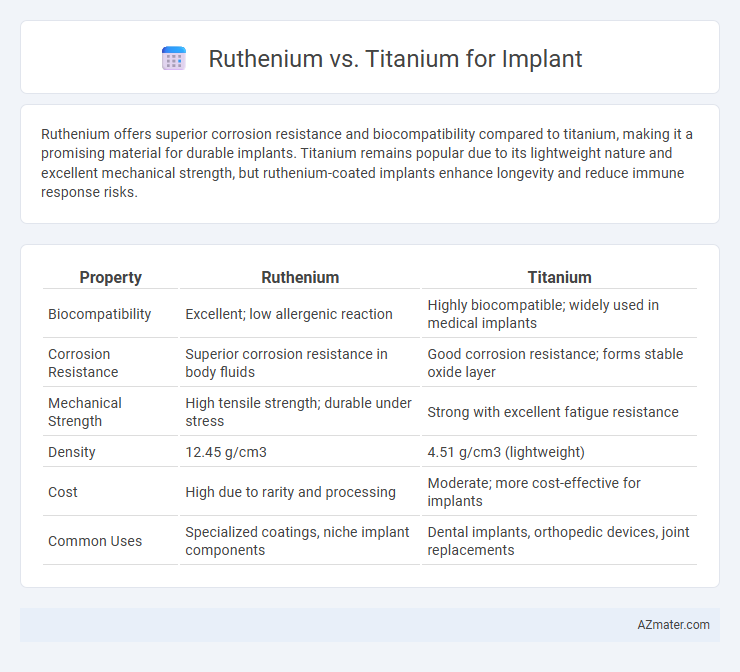Ruthenium offers superior corrosion resistance and biocompatibility compared to titanium, making it a promising material for durable implants. Titanium remains popular due to its lightweight nature and excellent mechanical strength, but ruthenium-coated implants enhance longevity and reduce immune response risks.
Table of Comparison
| Property | Ruthenium | Titanium |
|---|---|---|
| Biocompatibility | Excellent; low allergenic reaction | Highly biocompatible; widely used in medical implants |
| Corrosion Resistance | Superior corrosion resistance in body fluids | Good corrosion resistance; forms stable oxide layer |
| Mechanical Strength | High tensile strength; durable under stress | Strong with excellent fatigue resistance |
| Density | 12.45 g/cm3 | 4.51 g/cm3 (lightweight) |
| Cost | High due to rarity and processing | Moderate; more cost-effective for implants |
| Common Uses | Specialized coatings, niche implant components | Dental implants, orthopedic devices, joint replacements |
Introduction to Ruthenium and Titanium Implants
Ruthenium and titanium implants serve distinct roles in medical applications, with titanium being the industry standard due to its exceptional biocompatibility, corrosion resistance, and strength-to-weight ratio, making it ideal for orthopedic and dental implants. Ruthenium, a rare transition metal from the platinum group, is gaining attention for implant coatings that enhance surface durability and wear resistance without compromising biocompatibility. Comparing these materials involves evaluating titanium's proven track record in osseointegration against ruthenium's potential to improve longevity and performance through advanced surface engineering in implant technology.
Material Properties: Ruthenium vs Titanium
Ruthenium exhibits excellent corrosion resistance and high hardness, making it suitable for wear-resistant coatings on implants, while titanium is renowned for its exceptional biocompatibility, lightweight nature, and superior strength-to-weight ratio. Titanium's oxide layer promotes osseointegration, essential for stable implant fixation, whereas ruthenium's high modulus and durability provide enhanced resistance under mechanical stress but may pose challenges in biointegration. The combination of titanium's flexibility and ruthenium's hardness can be optimized to improve implant longevity and functional performance in biomedical applications.
Biocompatibility and Safety Comparison
Ruthenium exhibits excellent biocompatibility and corrosion resistance, making it a promising material for implants with minimal allergic reactions. Titanium remains the gold standard in implantology due to its proven biocompatibility, osseointegration capabilities, and long-term safety profile in clinical applications. Comparative studies indicate that while ruthenium offers favorable biochemical stability, titanium's extensive clinical use and established safety record make it more reliable for most implant applications.
Corrosion Resistance in Medical Applications
Ruthenium exhibits superior corrosion resistance compared to titanium in medical implants due to its stable oxide layer that effectively prevents degradation in body fluids. Titanium, while widely used for implants because of its strength and biocompatibility, can suffer from localized corrosion in aggressive environments such as chloride-rich bodily fluids. The enhanced corrosion resistance of ruthenium alloys offers improved longevity and reduced risk of metal ion release, making them a promising alternative for long-term medical implant applications.
Mechanical Strength and Durability
Ruthenium demonstrates superior mechanical strength compared to titanium, exhibiting higher hardness and resistance to deformation under stress. Titanium, widely used in implants, offers excellent biocompatibility and corrosion resistance but has lower tensile strength relative to ruthenium alloys. Durability-wise, ruthenium's enhanced wear resistance and fatigue life make it a promising candidate for load-bearing implant applications requiring long-term stability.
Implant Longevity and Performance
Ruthenium coatings enhance implant longevity by providing superior corrosion resistance and biocompatibility compared to titanium, which is widely known for its strength and osseointegration capabilities. Ruthenium's high hardness reduces wear and surface degradation, extending implant lifespan in load-bearing applications. Titanium implants maintain excellent mechanical stability and promote bone growth but may experience surface oxidation that can affect long-term performance.
Osseointegration: Bone Bonding Capability
Ruthenium, a rare transition metal, exhibits promising osseointegration properties due to its excellent corrosion resistance and biocompatibility, promoting strong bone bonding capability in implants. Titanium remains the gold standard in implantology with proven osseointegration effectiveness, attributed to its stable oxide layer facilitating direct bone-to-implant contact and rapid bone growth. Comparative studies suggest titanium shows superior long-term bone bonding strength, while ruthenium alloys may enhance surface bioactivity, offering potential benefits in specialized implant applications.
Allergic Reactions and Immune Response
Ruthenium-coated implants demonstrate lower allergic reactions and a reduced immune response compared to titanium due to their enhanced biocompatibility and corrosion resistance. Titanium, while widely used for implants because of its strength and biocompatibility, can occasionally trigger hypersensitivity in susceptible individuals, leading to inflammation or implant failure. Studies show ruthenium's unique surface chemistry minimizes protein adsorption and immune cell activation, making it a promising alternative for patients with metal allergies.
Cost and Accessibility of Ruthenium and Titanium
Ruthenium implants typically exhibit higher costs due to the metal's rarity and complex extraction processes, which limit widespread accessibility compared to titanium. Titanium remains the preferred choice in the implant market because of its abundant availability, cost-effectiveness, and well-established supply chains. The substantial price difference makes titanium implants more accessible for healthcare providers and patients, especially in large-scale or budget-sensitive applications.
Future Trends in Implant Material Innovation
Ruthenium is emerging as a promising implant material due to its exceptional corrosion resistance and biocompatibility, outperforming titanium in wear resistance and longevity for orthopedic applications. Research indicates that ruthenium-based coatings enhance osseointegration and reduce inflammatory responses, positioning it as a future trend in implant innovation. Advancements in nanotechnology and surface engineering are accelerating the adoption of ruthenium to develop next-generation implants with superior mechanical properties and bioactivity.

Infographic: Ruthenium vs Titanium for Implant
 azmater.com
azmater.com